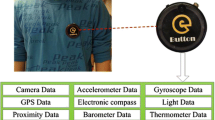Abstract
A fast and accurate computational model of HMM (Hidden Markov Model) is proposed for Activity Recognition System using inbuilt sensors of Smart Mobile Phone. Twelve features are calculated from the captured data and the feature vectors are divided into two vectors which are used as inputs to HMM. All computational methods follow probability theories and for measuring differences of two probability based events we used K–L divergence of Kullback and Leibler (Ann Math Stat 22(1):79–86, 1951) known as KLD (Kullback & Leibler Divergence). For comparing of feature values of ground truth and that of experimental values, we have developed an algorithm D-HMM (Divisional-HMM, proposed algorithm). Results show better recognition than existing HF-SVM (Hardware Friendly Support Vector Machine) and also better than our previous work of CFT (Conditional Features using Threshold, a method developed for using different schemes of threshold values for selection and matching purposes of feature values).










Similar content being viewed by others
References
Acharjee D, Mukherjee A, Mukherjee N (2012) Computing Aspects of monitoring walking disorder using body sensor network and neural network, The 2nd IEEE International Conference on ‘Parallel, Distributed and Grid Computing-PDGC2012’. http://ieeeXplore.ieee.org
Acharjee D, Mukherjee A, Mandal JK, Mukherjee N (2015) Activity recognition system using inbuilt sensors of smart mobile phone and minimizing feature vectors. J Microsyst Technol 21(5), Springer Pub. ISSN 0946-7076, Microsyst Technol. doi: 10.1007/s00542-015-2551-2
Aziz O, Lo B, Darzi A, Yang G-Z (2006) Introduction. In: Yang G-Z (ed) Body sensor networks. Springer, London, pp 1–39
Bandsenergy: http://www.pd-tutorial.com/english/ch03s08.html
Bashir FI, Khokhar AA, Schonfeld D (2007) Object trajectory-based activity classification and recognition using hidden Markov models. IEEE Trans Image Process 16(7):1912–1919
Cilla R, Patricio MA, García J, Berlanga A, Molina JM (2009) Recognizing human activities from sensors using hidden markov models constructed by feature selection techniques. Algorithms 2(1):282–300
IG-500A sub-miniature AHRS, SBG systems, France, Document-IG500AUM.11, Revision: 11 May 28 (2012) http://www.sbg-systems.com/Products/MiniatureInertialSystems
Keally M, Zhou G, Xing G, Wu J, Pyles A (2011) PBN: towards practical activity recognition using smartphone-based body sensor networks, SenSys-11, ACM 978-1-4503-0718-5/11/11
Kim D-J, Prabhakaran B (2011) Motion fault detection and isolation in Body Sensor Networks. Pervasive Mobile Comput 7:727–745 (Elsevier)
Kullback S, Leibler RA (1951) On information and sufficiency. Ann Math Stat 22(1):79–86
Lee Y-S, Cho S-B (2011) Activity recognition using hierarchical hidden markov models on a smartphone with 3D accelerometer, LNAI 6678, pp. 460–467, Springer-Verlag, Berlin
Moss L (2008) Example of the Baum--Welch Algorithm, source: www.indiana.edu/~iulgmosshmmcalculations.pdf. Accessed 16 May 2014
Pelc L, Kwolek B (2008) Activity recognition using probabilistic timed automata. In: Yin P-Y (ed) Pattern recognition techniques, technology and applications. Intech, Vienna, Austria, pp 626. ISBN 978-953-7619-24-4
Percentile computing: http://www.graphpad.com/guides/prism/6/statistics/index.htm?stat_percentiles_and_the_median.htm
Rabiner LR (1989) A tutorial on hidden markov models and selected applications in speech recognition. Proc IEEE 77:257–286
Roy SH, Cheng MS, Chang S-S, Moore J, De Luca G, Nawab SH, De Luca CJ (2009) A combined sEMG and accelerometer system for monitoring functional activity in stroke. IEEE Trans Neural Syst Rehabil Eng 17(6):585–594
Sánchez D, Tentori M, Favela Cicese J (2008) Activity recognition for the smart hospital. Ambient Intell IEEE, 1541-1672/08
Shnayder V, Chen B et al (2005) Sensor Networks for Medical Care, Technical Report TR-08-05, Division of Engineering and Applied Sciences, Harvard University, http://www.eecs.harvard.edu/˜mdw/proj/codeblue
Smith LI (2002) A Tutorial on Principal Component Analysis
Stamp M (2012) San Jose State University, A revealing introduction to hidden Markov models. http://www.cs.sjsu.edu/~stamp/RUA/HMM.pdf. 26 April
Trabelsi D, Mohammed S, Chamroukhi F, Oukhellou L, Amirat Y (2013) An unsupervised approach for automatic activity recognition based on hidden Markov model regression. arXiv:1312.6965v1 [stat.ML] 25 Dec 2013
Van Kasteren TLM, Englebienne G, Krose BJA (2010) An activity monitoring system for elderly care using generative and discriminative models. Pers Ubiquit Comput 14:489–498 (springerlink.com)
Wang L, Gu T, Chen H, Tao X, Lu J (2011) Real-time activity recognition in wireless body sensor networks: from simple gestures to complex activities, The Sixteenth IEEE International Conference on Embedded and Real-Time Computing Systems and Applications
Yu S-Z (2010) Hidden semi-Markov models. Artif Intell 174:215–243, 2009 Elsevier B.V. doi:10.1016/j.artint.2009.11.011
Zhu C, Sheng W (2012) Realtime recognition of complex human daily activities using human motion and location data. IEEE Trans B Eng 59(9):2422–2430
Author information
Authors and Affiliations
Corresponding author
Rights and permissions
About this article
Cite this article
Acharjee, D., Maity, S.P. & Mukherjee, A. Hidden Markov model a tool for recognition of human contexts using sensors of smart mobile phone. Microsyst Technol 23, 571–582 (2017). https://doi.org/10.1007/s00542-016-2973-5
Received:
Accepted:
Published:
Issue Date:
DOI: https://doi.org/10.1007/s00542-016-2973-5




